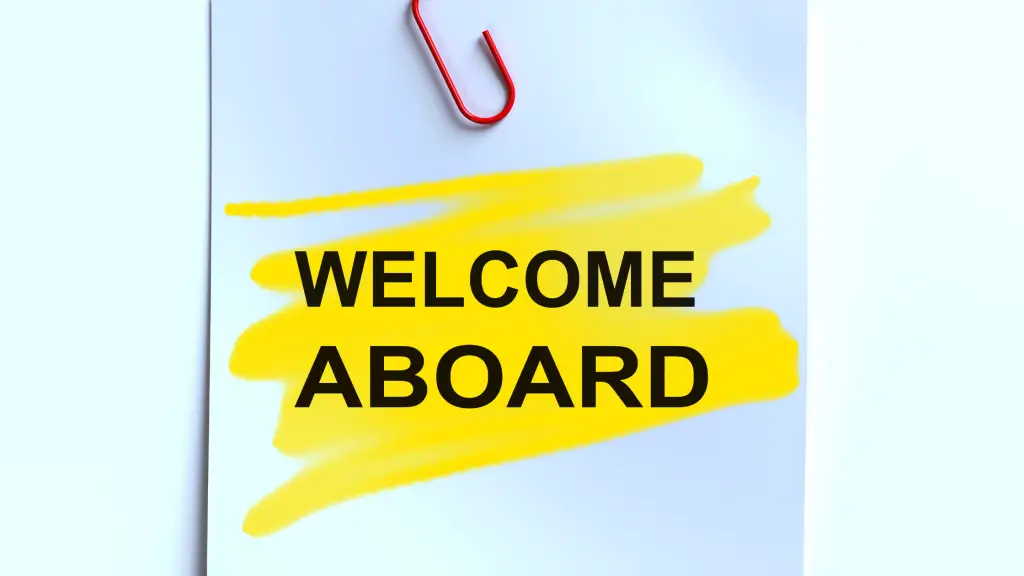When it comes to welcoming someone, the phrases “Welcome aboard” and “Welcome onboard” are often used interchangeably. However, there is a subtle difference between these two phrases that can make a difference in certain contexts. While both phrases convey a message of welcoming someone, they are used in different situations and carry different connotations.
The phrase “Welcome aboard” is commonly used in transportation industries, such as airlines and cruise ships, to greet passengers and make them feel welcome. It is also used to welcome new employees to a company or team, especially in a casual or friendly setting. On the other hand, “Welcome onboard” is often used in more formal settings, such as business emails or official letters, to welcome someone to a team or organization.
So, what’s the difference between “Welcome aboard” and “Welcome onboard”? While both phrases essentially mean the same thing, “Welcome aboard” is more commonly used and considered a more standard greeting. It is a casual and friendly way to welcome someone, while “Welcome onboard” is more formal and suitable for professional settings. Understanding the difference between these two phrases can help you choose the right one for the right situation.
Meaning and Usage
Welcome Aboard
“Welcome Aboard” is a common phrase used to greet people who are joining a team or a company, or when they are boarding public transportation such as a plane, train, or boat. The phrase is often used to convey a sense of warmth and hospitality and to make people feel welcome and comfortable.
The phrase “Welcome Aboard” is also used in the military to welcome new recruits to their unit or to a new assignment. In this context, it is used to convey a sense of camaraderie and to make new recruits feel like they are part of a team.

Welcome Onboard
“Welcome Onboard” is a similar phrase to “Welcome Aboard,” but it is less commonly used. The phrase is typically used in the context of transportation, such as when passengers are boarding a plane, train, or boat. The phrase is used to convey a sense of hospitality and to make passengers feel welcome and comfortable during their journey.
The phrase “Welcome Onboard” can also be used in a business context, such as when new employees are joining a company. However, it is less commonly used in this context and “Welcome Aboard” is the more standard and widely accepted phrase.
It is worth noting that the phrase “On Board” is often used to describe the location of something or someone on a vessel. For example, “The captain is on board the ship.” However, when used in the context of a greeting, “Welcome Onboard” is used to convey a sense of welcome and hospitality, rather than to describe a physical location.
Etymology
The terms “Welcome aboard” and “Welcome onboard” are both common phrases used to greet newly-hired employees or passengers. While they may seem interchangeable, there are subtle differences in their etymology and usage.
The phrase “Welcome aboard” has been in use for centuries and is derived from the nautical term “aboard,” which refers to being on or inside a vessel. The term “aboard” first appeared in the English language in the 14th century and was used to describe being on a ship or boat. Over time, the phrase “Welcome aboard” became a popular greeting among sailors and eventually spread to other industries, such as aviation and hospitality.
The phrase “Welcome onboard,” on the other hand, is a more recent addition to the English language. It is a combination of the words “on” and “board” and is commonly used in the aviation industry to welcome passengers onto a plane. The phrase is often used to describe the act of entering a vehicle or transport, such as a plane, train, or boat.
While both phrases are used to welcome people, their origins and usage are slightly different. “Welcome aboard” is more commonly used in a nautical context, while “Welcome onboard” is more commonly used in aviation and transportation contexts.
Examples of Usage
Both “Welcome Aboard” and “Welcome Onboard” are commonly used in various settings. Here are some examples of how they are used:
- In the workplace: “Welcome aboard the team, we’re excited to have you join us!”
- On a plane or boat: “Welcome aboard this flight to Paris.”
- On a cruise ship: “Welcome aboard the Carnival Breeze!”
- In a formal setting: “We would like to welcome you onboard this prestigious committee.”
As you can see, “Welcome Aboard” is more commonly used in workplace settings, while “Welcome Onboard” is more commonly used in transportation settings. However, both phrases can be used interchangeably in many situations.

It’s worth noting that some people may have a preference for one phrase over the other, but ultimately it comes down to personal preference and the context in which it is being used.
Differences between Welcome Aboard and Welcome Onboard
Although both phrases are used to welcome someone, there are some differences between “Welcome Aboard” and “Welcome Onboard”.
The main difference between the two phrases is that “Welcome Aboard” is considered less formal than “Welcome Onboard”. “Welcome on board” is more formal and is more suitable when it comes to welcoming someone to a team via email. On the other hand, “Welcome Aboard” is typically used to greet newly-hired employees or passengers and is considered more casual and friendly.
Lastly, “Welcome Onboard” is technically more grammatically correct because “onboard” is one word. “Aboard” is both an adverb and a preposition, meaning it describes a verb or a command. “Aboard” is not a location. It is a course of action. It must follow the verb straight without a preposition between it and “aboard”.
